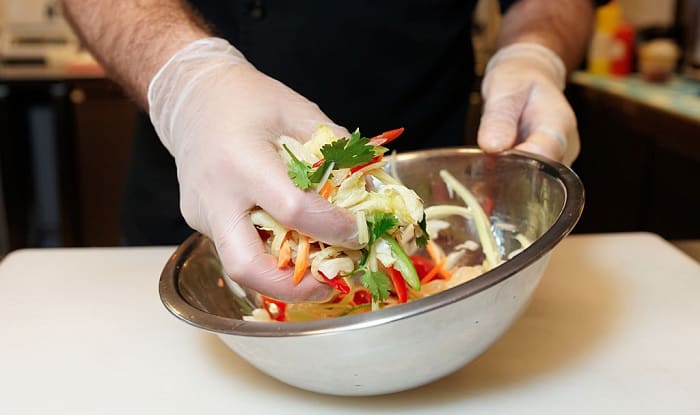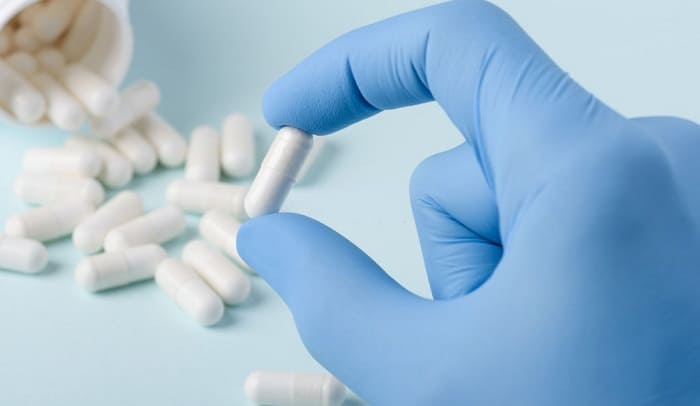Many people believe that as long as they wear gloves, they and their clients are completely safe from cross-contamination. That is not always true. As helpful as gloves are, they are no magic. They can easily become contaminated just like human hands. Pathogen transmission will only reduce when employees learn how and when they should change gloves. So, which activity requires a new pair of gloves?
In food service settings, workers need to change to new gloves when they resume a task after an interruption, such as taking a phone call or cleaning. They also need new gloves when switching from preparing raw meat to ready-to-eat food.
In medical settings, caregivers must not wear the same gloves to take care of more than one patient. In addition, they must don new gloves when switching from caring for one contaminated body site to another.
Table of Contents
Food Service Glove Usage
The US Food Safety and Inspection Service has pointed out that bare hand contact with food is one of the main sources of foodborne illness spreading. Every surface you touch might contain harmful bacteria, which can easily pass on to the food you handle and your customers. The FDA has made it mandatory that food handlers wear disposable gloves when preparing any ready-to-eat food.
However, wearing gloves doesn’t guarantee that pathogens won’t transfer because gloves can become contaminated during food-handling processes. To promote a sanitary environment, you should don a new pair under the following circumstances:
- The gloves become dirty or show signs of non-intergrity.
- You have worn the same gloves for more than four hours.
- You resume a task after an interruption (e.g., taking a phone call, being called to do another job, cleaning spills, taking out the garbage).
- You switch from handling raw meat, seafood, or poultry to ready-to-eat food.
Workers should only wear gloves approved for food service and appropriate for the task. For example, use longer gloves for mixing food. You can also buy disposable gloves in distinctive colors for different tasks.
You don’t have to wear single-use gloves when:
- Handling raw agricultural products.
- Washing whole produce.
- Handling ingredients that will be cooked to the correct internal temperature.
You can refer to this video for more details about food service glove usage:
Medical Glove Usage
In medical settings, gloves are vital to reduce the risk of cross-contamination of healthcare workers with blood, bodily fluid, and the patient. They should be worn during all patient-care activities that might involve exposure to blood and secretions.
Besides knowing when to wear gloves, caregivers must learn when to change gloves to prevent the transmission of pathogens. Here is a list of activities that require a new pair of gloves:
- When a glove’s integrity is compromised (e.g., puncture, split).
- When caring for one patient after another.
- When moving from one contaminated body site to another body site within one patient.
- When the caregiver has worn the same gloves for more than four hours.
But don’t forget that unnecessary use of gloves results in a waste of resources. You should plan and perform medical procedures in a rational sequence and use non-touch techniques when possible to minimize the need for donning and changing gloves.
Precautions When Changing Gloves
When you change gloves, follow these precautions:
- Always wash your hands thoroughly with soap and water before putting on new gloves. This helps keep bacteria from spreading in the event of gloves’ non-integrity.
- Always check for defects on your gloves before donning. While using, keep an eye on the gloves to spot rips or tears, especially when working with sharp objects.
- Only wear gloves that fit comfortably. Tight gloves might rip easily, whereas loose gloves might fail to provide adequate coverage and protection.
- Don’t share your disposable gloves with other workers.
- Washing and reusing single-use gloves are not recommended.
The Bottom Line
We hope this article on which activity requires a new pair of gloves helps you gain knowledge about appropriate hygiene practices. CDC estimates that one out of six Americans gets sick from foodborne illness each year. Thus, proper glove usage is crucial to protect you and your customers. Always keep the basic principles to maintain a safe and sanitary workplace in mind.

Veronica is our content editor. She is a talent in delivery. Her main work is editing and writing articles that are both informative and simple to follow. She is in charge of synthesizing our understanding of what personal protection equipment (PPE) is needed in each job, how to best apply it, and how to visualize that equipment.



